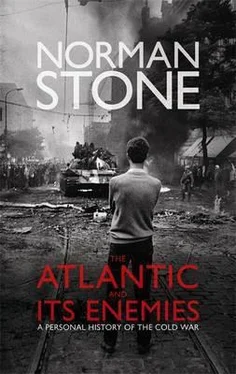Martial law had been declared at the end of 1981, and had solved nothing: Poland still had the debts, and after a week or two the black market ran things as before. In effect it was the Pope (with the American embassy) that now ran affairs. In June 1983 he returned to Poland. If he had called for a revolution, it would have happened. He did not. The virtues of capitalism and democracy did not much interest him and in 1984 Jaruzelski himself said that the Church was an ally. There was a curious aspect, that many of the people in the Reagan administration were Catholic: Haig’s brother was a priest, and there was William Casey at the CIA. Oleg Bogomolov, for the Institute of Socialist Relations, had written a report in 1978 about what the Pope would do. It is worth noting that both Khrushchev and Brezhnev, with Ukrainian involvement, disliked the Uniates as fake. John Paul went again in 1987 and three quarters of a million people attended the Mass at Gdańsk. There had been a referendum on economic reform, boycotted at the behest of Solidarność, and strikes had followed in the spring (1988). Lech Wałęsa was needed, and in January 1989 he appeared on television again. Mieczysław Rakowski took over as prime minister, and in February 1989 there was a round table over the price increases. The elections then occurred in June, and by now Gorbachev and the Pope were co-operating. Gorbachev informed Cardinal Agostino Casaroli in Moscow in the ineffable words: ‘The most important thing is the human being. The human being must be at the centre of international relations. That is the point of departure for our New Thinking.’ And he did release the Lithuanian Cardinal Vincentas Sladkevičius, after twenty-five years in prison. In return he had a present: the Virgin of Fatima had promised that Russia would be freed. In the summer of 1989 Poland acquired a non-Communist government, the members of which undertook to leave the Communists alone. Opinions greatly varied as to the wisdom of this, and Alain Besançon made himself unpopular, as he talked of another Convention of Targowice, or sell-out. But was there a serious alternative? Gorbachev, by now doing the rounds of ‘our common European home’, had to act over Poland, and if the Church and the Americans pushed the Poles towards a compromise element, so be it. But he would also have to get rid of ugly, tiresome little Honecker as well.
Poland was really about Germany, and another important People’s Democracy also supervened. Act two was set in Hungary. János Kádár, the general secretary, had promised some economic liberalization and had impressed Mitterrand. Hungary had always had a strange relationship with Austria, and Austria was now, in her way, a considerable success story. Why was Budapest, capital of what was in the end a rather more interesting civilization, such a lifeless ruin? Something of an effort was made to do something with Budapest, and at least the Váci utca and the old Gerbeaud café were very smudgy copies of the Herrengasse and the Sacher in Vienna, though if you went two or three tram stops down the Rákóczy út you were well and truly in the Communist bloc. Kádár was a prime opportunist, and the Russians needed him: he was very adept at making sure that he had no obvious successor. Besides, there was an enormous and very influential Hungarian diaspora, and after Ostpolitik its members came back and forth — latterly in the shape of George Soros. Hungary built up the largest per capita dollar debt in the world, $2bn, but the industrial showcases were not a success. In the recession of the early 1980s exports to the West ran down, and half of the earnings were needed just to pay the debt interest. Wages were blocked, there was notable inflation, and purchasing power fell by 15 per cent. Hungary had a degree of liberalization, Kádár announcing that who was not against was for, and there were opposition movements, with openings in the press. By 1985 there were public meetings, and in 1987 when Kádár was already 75 there was something of a turning point: the state enterprises were allowed to charge their own prices, but on the other side personal taxes were introduced. Imre Pozsgay circulated a document by the main economists, saying that the regime had led the country to near disaster, and in March 1988 — the anniversary of the revolution in 1848 — thousands of demonstrators gathered in Budapest. Viktor Orbán started to make his reputation as orator (and eventual prime minister). At the next Party conference, Kádár himself was voted out, and at another anniversary, the execution of Imre Nagy in 1958, the end of the Party itself was spelled out. Nagy had said that he feared being rehabilitated by his own executioners and that is what happened: the Communists shed their name and carried on as social democrats, or even as liberals.
Soviet leaders all along had tried to split Germany from the Atlantic alliance. In the later 1970s Brezhnev visited Bonn. There were German neutralists, and it even became chic in West Germany to talk as if all differences with the USSR could somehow be smoothed over. But the central problem remained, that the State which called itself the ‘German Democratic Republic’ was an embarrassment. It remained a place where the inhabitants had to be contained by a wall, and a very ugly one at that, complete with minefields and yapping hounds on dog-runs, in case they all decided to move out, as they had done before 1961, when the Wall was built. Erich Honecker was saying that the Wall would last for fifty years, and there was another very odd aspect to it, that many Germans agreed. Hans-Magnus Enzensberger wrote an essay saying the Wall would be an historical curiosity, and there were many West Germans with egg on their faces when it came down.
The East German state had already been reduced to a formality, kept going by the West. The Lutheran Church managed the sale of prisoners — 2,300 in 1983 and 1984, and emigration was anyway going ahead: a worker cost DM50,000 and a graduate DM200,000. From 1965 to 1988 30,000 were thus bought out, for DM2bn. Thirty thousand left legally every year while about 40,000 managed to escape (1961-88) and ten-day family visits went west (1.3 million in 1987). In 1981 East Germany owed $13bn and that took 43 per cent of export earnings; the Soviets did give loans but also cut back on cheap oil (hence the stink of lignite in Erfurt). In July 1983 it was Franz Josef Strauss (ambitious to be foreign minister) who negotiated with East Berlin — West German banks lending an interest-free billion Marks and another billion in 1984. The East Germans had reduced their trade with the West generally but it rose with West Germany. There were no customs barriers, and Strauss extracted two secret notes from Honecker as to the relaxation of border controls so as to prevent the strip-searching of children. Richard von Weizsäcker, as mayor of West Berlin, used to cross the border to discuss the S-Bahn and matters of pollution as no predecessor had done. Schmidt visited Honecker in 1981 and Honecker wanted to return but there were problems with Moscow and the Czechs and Poles, and besides Moscow had said that there would be no more such rapprochement if the Euro-missiles went ahead. Honecker therefore had to say in 1984 that he would not go, although in 1987 he indeed did. There he found a West Germany that gave him a welcome.
The SPD to Schmidt’s great disapproval now flirted with him, and in 1985 Oskar Lafontaine, minister-president of the Saarland, talked of accepting a separate nationality; in 1986 he even proposed a nuclear-free zone, though there had been the absurd ceremony for twenty-five years of the Wall, including a preposterous DDR stamp of a young girl giving flowers to soldiers shooting refugees. There was even a ridiculous ‘Values Commission’ of the SPD and the Academy of Sciences in East Berlin, and when the end came the Lutheran Churches were forbidden to ring their bells. It remains extraordinary that Bonn did not see the end coming: it was only in the spring of 1989 that Chancellor Kohl told the French he could see great problems coming for the East German state. In 1988 9,000 East Germans had got out through a country of the bloc where holidays were allowed — mainly Poland. In 1989, in the summer, tens of thousands moved out via Hungary and Austria. This was voting with feet, and Moscow did nothing to prevent it. The heart of the whole business was Germany. Russia and Germany had had the key relationship, and by 1988 the Gorbachev team were in creative mode. How could they get rid of Honecker and his colleagues? The answer lay in Hungary. The prime minister, Miklós Németh, had been promised DM500m if the border were opened (April, in Bonn). In June 1989 Gorbachev came to Bonn on an official visit. He told Kohl that whole areas of the USSR might need immediate help. Kohl consulted no-one and said the first despatches would happen at once. The East German parliament had approved of Tiananmen Square and on 13 June Gorbachev said that it would not happen in Red Square, and the communiqué of 13 June in Bonn spoke of ‘self-determination’. Much was made of an East German resistance that was now mostly stage-managed. The Protestants were restive and 120 young protestants who sat in before a church, protesting against local elections with their 98.5 per cent yes vote, were arrested, but then the church went to court over the electoral fraud and the prisoners were released (May). Even the SPD ‘Values Commission’ protested in March against long prison sentences for the Justice and Peace Work Circle. In July at the Kirchentag , or Church congress, there were clashes and from then on at the Nikolai-Kirche growing numbers appeared every Monday protesting at not being allowed to go west: curious that Saxony, the heart of the wretched state, was also its end. Honecker was quite remote and cushioned by Stasi reports, but on 10 September the Hungarians opened the border with Austria.
Читать дальше












![Edward Ellis - Adrift on the Pacific - A Boys [sic] Story of the Sea and its Perils](/books/753342/edward-ellis-adrift-on-the-pacific-a-boys-sic-s-thumb.webp)